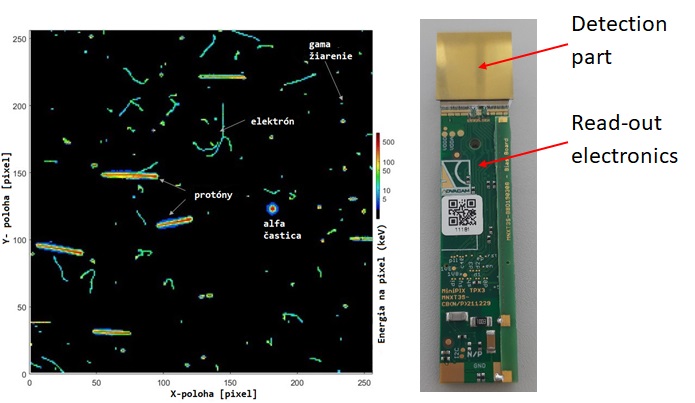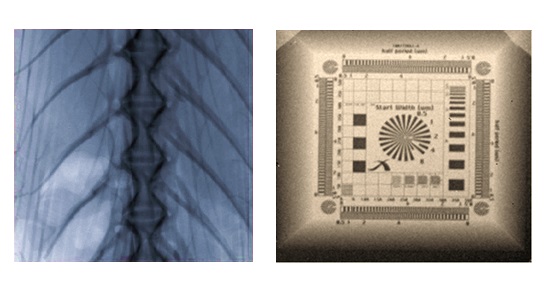
Ionizing radiation is manifested by various physical phenomena as it passes through the material environment, some of which are used to detect or measure its characteristics. The basic part of the device for measuring ionizing radiation is a detector or sensor. The sensitive part of the sensor is a semiconductor material such as silicon, gallium arsenide, cadmium telluride, indium phosphide, silicon carbide, etc. Depending on the type of ionizing radiation (alpha, beta, X-rays, gamma rays, etc.) and its characteristics that we want to detect, it is necessary to adapt the parameters of the semiconductor sensor (total sensitive area, thickness, etc.). In the department, we prepare and test e.g. “single” detectors and then pixel 2D structures for a digital radiation camera (Figure 1). We use SiC (silicon carbide), GaAs (gallium arsenide), and polycrystalline diamond as basic detection materials.

Fig 1. a) Photo of encapsulated e.g. “single” SiC-based detector; b) GaAs-based semiconductor substrate with prepared pixel structures with a single pixel size of 55 × 55 mm2.
The prepared semiconductor detectors are connected to read-out electronics that process signals from the detector. The detectors are capable of measuring the energy of ionizing radiation with high accuracy. Figure 2a shows the measured SiC-based alpha particle peaks generated by the radioisotopes 239Pu, 241Am and 244Cm. For example, the SiC sensor can operate at high temperatures. Figure 2b shows the detection capabilities of a 3mm thick polycrystalline diamond detector.

Fig. 2. a) Alpha particle spectrum obtained with a prepared SiC-based detector; (b) and a polycrystalline diamond-based detection structure.
Pixel 2D detector arrays are suitable for the detection of ionizing radiation. From the detection track it is possible to determine the type of particle and also its energy. Figure 3 shows tracks of different types of radiation (protons, electrons, alpha particles, and gamma rays) detected by a SiC-based radiation camera. The typical pixel count of a radiation camera is 256 × 256 pixels or multiples of that.

Fig. 3. Tracks of protons, electrons, alpha particles, and gamma rays registered by a SiC-based pixel radiation camera.
Another way to use a radiation camera is X-ray imaging. Since X-rays pass through objects, we can use such a camera to see the internal structure of the test object without having to disassemble it and often damage it. Figure 4 on the left shows the skeleton of a small fish obtained using a radiation camera developed in our department. On the right is a test image used to evaluate the image quality of a radiation camera.

Fig. 4. X-ray image of the skeleton of a small fish (left) and test pattern (right) obtained by a pixel radiation camera.
Research staff:
Selected publications:
Zaťko, B., Šagátová, A., Hrubčín, L., Kováčová, E., Novák, A., Kurucová, N., Polansky, Š., and Jakůbek, J.: Imaging and spectrometric performance of SiC Timepix3 radiation camera, J. Instrument. 19 (2024) C01003.
Novák, A., Granja, C., Šagátová, A., Jakubek, J., Zaťko, B., Vondracek, V., Andrlik, M., Zach, V., Polansky, Š., Rathi, A., Oancea, C.: Silicon Carbide Timepix3 detector for quantum-imaging detection and spectral tracking of charged particles in wide range of energy and field-of-view, J. Instrument. 18 (2023) C11004.
Gál, N., Hrubčín, L., Šagátová, A., Vanko, G., Kováčová, E., and Zaťko, B.: High-resolution alpha-particle detector based on Schottky barrier 4H-SiC detector operated at elevated temperatures up to 500 °C, Applied Surface Sci 635 (2023) 157708.
Šagátová, A., Gál, N., Novák, A., Kotorová, S., Riabukhin, O., Kováčová, E., and Zaťko, B.: GaAs radiation-degraded detectors: gamma spectrometry at lowered temperatures, J. Instrum. 17 (2022) C12018.
Zaťko, B., Šagátová, A., Gál, N., Novák, A., Osvald, J., Boháček, P., Polansky, Š., Jakůbek, J., and Kováčová, E.: From a single silicon carbide detector to pixelated structure for radiation imaging camera, J. Instrum. 17 (2022) C12005.
Sedláčková, K., Zaťko, B., Šagátová, A., and Nečas, V.: Polarization effect of Schottky-barrier CdTe semiconductor detectors after electron irradiation, Nuclear Instr. Methods Phys. Res. A 1027 (2022) 166282.
Osvald, J., Hrubčín, L., and Zaťko, B.: Temperature dependence of electrical behaviour of inhomogeneous Ni/Au/4H–SiC Schottky diodes, Mater. Sci Semicond. Process. 140 (2022) 106413.
Zaťko, B., Hrubčín, L., Šagátová, A., Osvald, J., Boháček, P., Kováčová, E., Halahovets, Y., Rozov, S.V., and Sandukovskij, V.G.: The study of Schottky barrier detectors based on high quality 4H-SiC epitaxial layer with different thickness, Applied Surface Sci 536 (2021) 147801.
Zápražný, Z., Zaťko, B., Korytár, D., Gál,, Jergel, M., Halahovets, Y., and Ferrari, C.: Testing of thickness homogeneity of Si crystal membranes using GaAs Timepix detector, J. Instrument. 16 (2021) P06015.





